New Delhi, (Asian independent) Scientists have reported the first evidence that our Earth and the universe around us are awash in a background of spacetime undulations called gravitational waves.
Gravitational waves, ripples in the fabric of time-space predicted by Albert Einstein more than a century ago, are permeating the universe at low frequencies, according to a multiyear National Science Foundation (NSF) project.
The findings, reported in a series of papers in The Astrophysical Journal Letters, come from 15 years’ worth of observations made by the North American Nanohertz Observatory for Gravitational Waves (NANOGrav) with more than 190 scientists from the US and Canada.
Detecting a “chorus” of low-frequency gravitational waves is a key to unlocking the mysteries of how structures are formed in the cosmos.
NANOGrav used data from radio telescopes — the Arecibo Observatory in Puerto Rico, the Green Bank Telescope in West Virginia, and the Very Large Array in New Mexico — to monitor 68 dead stars, called pulsars, in the sky.
The pulsars acted like a network of buoys bobbing on a slow-rolling sea of gravitational waves.
The waves oscillate very slowly over years and even decades and are thought to originate primarily from pairs of supermassive black holes leisurely spiralling together before they merge.
“The effect of the gravitational waves on the pulsars is extremely weak and hard to detect, but we built confidence in the findings over time as we collected more data,” says Katerina Chatziioannou, a NANOGrav team member.
“In the future, we will continue to make more observations and will compare our results with those from international partners, which will allow us to learn more from the data,” she added.
Gravitational waves were first proposed by Albert Einstein in 1916 but were not directly detected until about 100 years later when the National Science Foundation funded LIGO picked up the waves from a pair of distant colliding black holes.
LIGO detects gravitational waves that are much higher in frequency than those registered by NANOGrav.
“We have a new way of probing what happens as monstrous black holes at the cores of galaxies begin a slow but inexorable death spiral,” said Joseph Lazio, a NANOGrav team member, a principal scientist at the Jet Propulsion Laboratory (JPL), NASA.
In the new studies, NANOGrav is thought to have picked up a collective hum of gravitational waves from many pairs of merging supermassive black holes throughout the universe.
“People compare this signal to more of a background murmur as opposed to the shouts that LIGO picks up,” explained Chatziioannou.
With this discovery, the scientists hope to answer mysteries about the nature of merging supermassive black holes, such as how common they are, what brings them together, and what other factors contribute to their coalescence.








